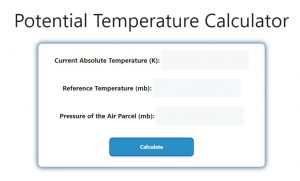About Potential Temperature Calculator (Formula)
The Potential Temperature Calculator is an essential tool in meteorology, allowing scientists and weather enthusiasts to calculate the potential temperature of an air parcel. Potential temperature is the temperature that an air parcel would attain if it were brought adiabatically to a standard reference pressure, typically 1000 hPa. This value is crucial for understanding atmospheric stability, buoyancy, and the behavior of air masses. This article explains the formula, how to use the calculator, and answers frequently asked questions.
Formula
The formula to calculate potential temperature is:
Potential Temperature = Temperature * (Reference Pressure / Pressure) ^ (R / Cp)
Where:
- Potential Temperature: The temperature of the air parcel at the reference pressure.
- Temperature: The initial temperature of the air parcel in Kelvin (K).
- Reference Pressure: The standard pressure, typically set at 1000 hPa.
- Pressure: The actual pressure of the air parcel in hPa.
- R: The specific gas constant for dry air (approximately 287 J/(kg·K)).
- Cp: The specific heat capacity at constant pressure for dry air (approximately 1005 J/(kg·K)).
How to Use
- Measure the Initial Temperature: Determine the temperature of the air parcel in Kelvin.
- Obtain Actual Pressure: Measure or find the actual pressure of the air parcel in hPa.
- Use Reference Pressure: Typically, use 1000 hPa as the reference pressure.
- Apply the Formula: Substitute the values into the formula to calculate the potential temperature.
Example
Suppose you have an air parcel with a temperature of 290 K and an actual pressure of 850 hPa. To calculate the potential temperature:
- Given:
- Temperature = 290 K
- Actual Pressure = 850 hPa
- Reference Pressure = 1000 hPa
- Calculation: Potential Temperature = 290 * (1000 / 850) ^ (287 / 1005)
First, calculate the fraction:
- (1000 / 850) ≈ 1.1765
Next, raise it to the power of (287 / 1005):
- 1.1765 ^ 0.2851 ≈ 1.0594
Finally, multiply by the temperature:
- Potential Temperature ≈ 290 * 1.0594 ≈ 307.24 K
Thus, the potential temperature of the air parcel is approximately 307.24 K.

FAQs
- What is potential temperature?
Potential temperature is the temperature an air parcel would have if brought adiabatically to a reference pressure. - Why is potential temperature important in meteorology?
It helps in analyzing atmospheric stability and understanding air mass behavior. - What units are used for temperature in this calculation?
The temperature should be in Kelvin (K). - What is the reference pressure typically used?
The standard reference pressure is usually set at 1000 hPa. - Can potential temperature be calculated at any pressure?
Yes, it can be calculated using the actual pressure of the air parcel. - What are R and Cp in the formula?
R is the specific gas constant for dry air, and Cp is the specific heat capacity at constant pressure. - How does potential temperature relate to stability?
Higher potential temperatures indicate less stable air parcels, while lower values suggest stability. - Is potential temperature useful for weather forecasting?
Yes, it provides insights into atmospheric processes and helps in predicting weather patterns. - What happens to potential temperature in rising air parcels?
As an air parcel rises, its potential temperature decreases due to expansion and cooling. - How do you convert temperature from Celsius to Kelvin?
To convert Celsius to Kelvin, add 273.15 to the Celsius temperature. - What is the typical value of R for dry air?
R is approximately 287 J/(kg·K) for dry air. - How can potential temperature help identify air masses?
Different air masses will have distinct potential temperatures, aiding in classification. - Can potential temperature be used in climate studies?
Yes, it is useful for understanding long-term climate trends and variations. - How does potential temperature relate to buoyancy?
Air parcels with lower potential temperatures tend to sink, while those with higher values rise. - Is potential temperature affected by humidity?
The formula assumes dry air, so it does not account for moisture content directly. - How do you measure the actual pressure of an air parcel?
Actual pressure can be measured using barometers or obtained from weather stations. - What is the significance of using adiabatic processes?
Adiabatic processes help model how air parcels change temperature without heat exchange. - What tools can I use to calculate potential temperature?
You can use scientific calculators, spreadsheets, or online calculators designed for this purpose. - Are there limitations to potential temperature calculations?
The calculations assume dry air and may not apply accurately in humid conditions. - How often should potential temperature be calculated in meteorological studies?
It is advisable to calculate it regularly, especially during weather changes or atmospheric studies.
Conclusion
The Potential Temperature Calculator is a vital tool for meteorologists and anyone interested in atmospheric science. Understanding potential temperature allows for better insights into atmospheric stability, buoyancy, and the behavior of air masses. By following the formula and applying the calculations correctly, users can enhance their understanding of weather patterns and contribute to more accurate forecasting.